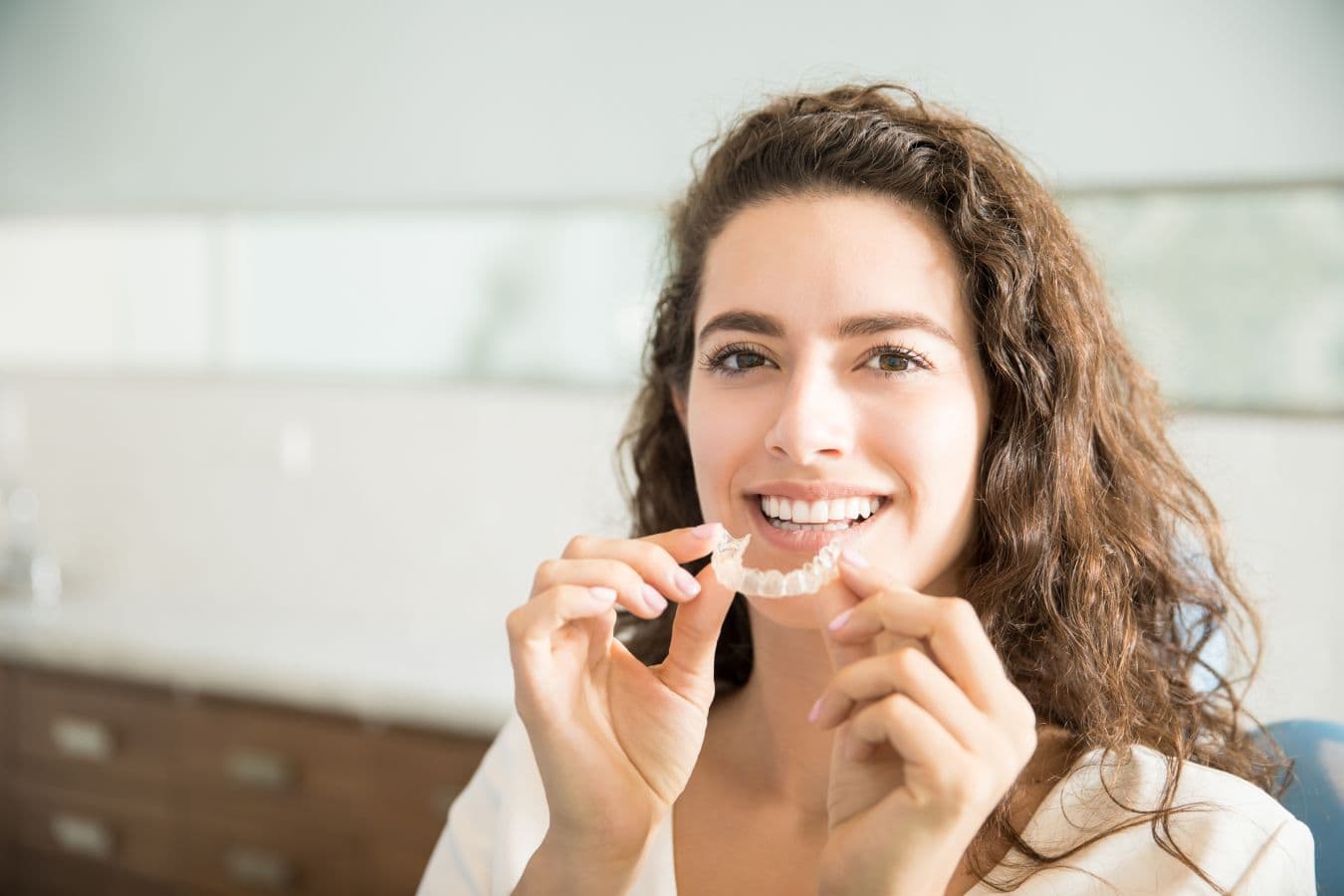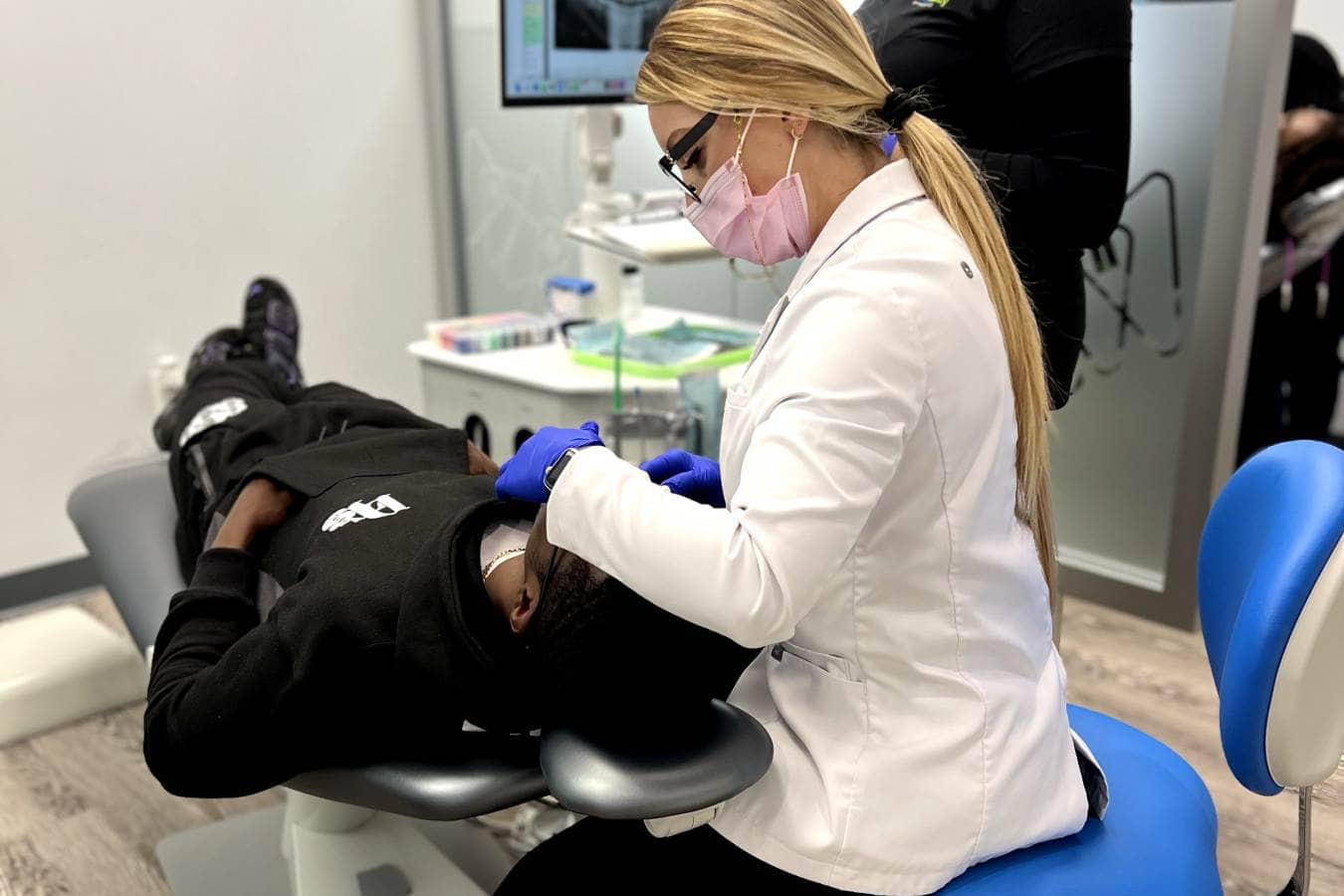Two-Phase Treatment
At Bartley Family Orthodontics, we are dedicated to providing the most effective and efficient orthodontic solutions for our patients. One approach we use is the two-phase treatment, a specialized process that combines tooth straightening and physical, facial changes. This method allows us to achieve a healthy, functional, and aesthetically pleasing result that will remain stable throughout your life.
Two-phase treatment is a specialized orthodontic process that involves two separate periods of treatment: Phase 1 (Early Treatment) and Phase 2 (Full Treatment). These phases are separated by a resting period.
Phase 1: Early Treatment
The goal of Phase 1 is to help jaw development, ensuring there’s enough space for all permanent teeth to erupt properly. It can also correct significant problems like crossbite, overbite, underbite, or harmful oral habits. This phase typically involves the use of special appliances or partial braces and usually starts when the child has a mix of baby and permanent teeth, around the age of 6 to 10.
Resting Period
Following Phase 1, there’s a Resting Period where no active orthodontic treatment takes place. During this time, the remaining permanent teeth are allowed to erupt on their own. Retainers may be used to maintain the results of Phase 1 while we wait for the rest of the teeth to come in. Regular monitoring is done to ensure teeth are erupting correctly and timely.
Phase 2: Full Treatment
Phase 2 commences once all permanent teeth have erupted. The goal of this phase is to ensure each tooth has an exact location in the mouth for optimal function and aesthetic appeal. This phase typically involves full upper and lower braces and lasts for an average of 12-24 months.
Why two-phase treatment?
Two-phase treatment offers several advantages:
- Preventive Approach — Early identification and correction of orthodontic problems can prevent more serious issues in the future.
- Improved Appearance — The treatment can enhance facial symmetry and aesthetics by guiding jaw development.
- Efficiency — It often reduces the need for tooth removal or more invasive procedures later.
At Bartley Family Orthodontics, we promise to deliver exceptional care during every phase of your orthodontic journey. Contact us today to learn more about our two-phase treatment approach and how it can benefit you or your child.
Zoom Whitening
At Bartley Family Orthodontics, we believe that everyone deserves a bright, confident smile. That’s why we’re proud to offer Zoom Whitening, a state-of-the-art teeth whitening solution that can dramatically enhance your smile’s radiance. We proudly provide Zoom Whitening in Bridgeport, Stamford, and Windsor, CT, helping patients across these areas achieve the brilliant smiles they deserve.
Zoom Whitening is an advanced teeth whitening system that uses innovative technology to remove stains and discoloration from your teeth. Whether your teeth have been discolored by food, drink, smoking, or age, Zoom Whitening can help restore their natural whiteness.
Zoom Whitening stands out from over-the-counter whitening solutions for several reasons:
- Effectiveness — Zoom Whitening offers more dramatic results, often making teeth up to eight shades lighter.
- Speed — With the in-office treatment, you can achieve a noticeably whiter smile in just one hour.
- Customization — The at-home treatment offers the convenience of whitening your teeth on your own schedule, with custom-fitted trays for maximum comfort and effectiveness.
- Professional Supervision — Both treatments are overseen by our professional team, ensuring safety and optimal results.
in-office zoom whitening
Our in-office Zoom Whitening treatment offers immediate, noticeable results in just one visit. This professional-grade whitening procedure involves applying a specially formulated gel to your teeth, which is then activated by a proprietary LED light source. The light accelerates the whitening process, helping break up stains and discoloration in less than an hour. Most patients see their teeth become up to eight shades lighter after just one session.
take-home kits
For those who prefer to whiten their teeth at their own convenience, we also offer at-home Zoom Whitening kits. These kits include custom-fitted trays and a professional-grade whitening gel that you can apply in the comfort of your own home.
The treatment process is simple: you fill the trays with the provided whitening gel and wear them for a prescribed amount of time each day. Most patients start seeing results within a few days, with full results typically achieved in two weeks.
At Bartley Family Orthodontics, we’re committed to helping you achieve the bright, beautiful smile you’ve always wanted. Contact us today to learn more about Zoom Whitening and how it can transform your smile.
Propel Accelerated Treatment
Are you tired of long and tedious orthodontic treatment? Do you want to see faster results and spend less time in braces or aligners? Look no further than accelerated treatment with Propel.
At Bartley Family Orthodontics, we understand that our patients lead busy lives and may not have the time or patience for traditional orthodontic treatment. That’s why we are proud to offer accelerated treatment with Propel, a cutting-edge technology that speeds up the orthodontic process and delivers results in record time.
how does propel work?
Using micro-osteoperforations, Propel stimulates bone remodeling and accelerates tooth movement. This means you can achieve your dream smile in just 3-6 months, compared to the 1-2 years it takes with traditional methods.
Not only does accelerated treatment with Propel save time, but it also reduces discomfort during the orthodontic process. With traditional methods, patients often experience soreness and discomfort after adjustments. But with Propel, the gentle yet effective movement of teeth means less pain and shorter recovery times.
Don’t wait any longer for your perfect smile. Request a consultation with Bartley Family Orthodontics today and ask about accelerated treatment with Propel. Our experienced orthodontists will assess your unique case and determine if this revolutionary technology is right for you. Don’t settle for slow and outdated orthodontic methods — choose accelerated treatment with Propel and get the smile you deserve in no time.
Sleep Apnea Treatment
As a specialist with several years of advanced training in the field of dentofacial orthopedics, our orthodontists have a comprehensive knowledge of facial growth and development and are well-equipped to recognize the multiple anatomical and airway anomalies that can contribute to the development of obstructive sleep apnea.
An orthodontist routinely diagnoses and treats a wide range of dental and skeletal issues that can affect the airway (nasopharyngeal & oropharyngeal passages) and/or be indicative of obstructed breathing including:
- An underdeveloped or recessed lower jaw
- A high-vaulted palate (roof of the mouth)
- Narrow upper and lower jaws
- Severe crowding
Moreover, our orthodontist can also identify enlarged tonsils and adenoids, mouth breathing, and other functional as well as other skeletal and soft tissue issues that can contribute to obstructive sleep apnea in both children and adults.
Working as part of an interdisciplinary team with sleep medicine specialists, ENTs, and primary care physicians, our orthodontist can help diagnose obstructive sleep apnea and provide orthodontic treatment and oral appliances to support positive airway changes that can alleviate the symptoms and consequences of this disorder.
TMJ/TMD Treatment
According to the National Institute of Dental and Craniofacial Research (NIDCR), temporomandibular joint disorders (TMJ), also referred to as temporomandibular disorders (TMD), are the most common source of chronic facial pain and jaw dysfunction. It is estimated that more than 10 million people in the United States are affected by temporomandibular joint problems.
what is the temporomandibular joint?
There are two temporomandibular joints that connect the left and right sides of the lower jaw to the temporal bone. Both joints and their associated muscles, ligaments, and tendons work together to allow for all manner of oral functions as the jaw moves up and down, front to back, and from side to side. Containing a shock-absorbing, soft disc that sits between the rounded condyles of both sides of the lower jaw and the corresponding concavities in the skull’s temporal bone, the TMJ makes chewing, speaking, yawning, and all jaw movements possible.
Since the TMJ is a joint with both up and down hinge-like movements, as well as side-to-side and front-to-back sliding motions to perform, it is often considered one of the most complicated joints in the body and one of the most difficult to treat when problems arise.
types & symptoms of TMJ Disorders
TMJ disorders can fall into one or more of the following three categories:
- Myofascial Pain — Refers to pain in the area of the jaw joint due to various causes of increased muscle tension and spasms.
- Internal Derangement — Involves displacement of the disc, jaw dislocation, or trauma to the condyles of the jaw.
- Degenerative Joint Disease — This can be Arthritis or similar conditions.
The risk for developing a TMJ problem is greater in the presence of long-term teeth grinding or bruxism, a jaw injury, or various types of arthritis such as rheumatoid arthritis and osteoarthritis. Furthermore, the manifestations of a TMJ disorder can vary from person to person with a wide range of symptoms possible, including earaches, ringing in the ears (tinnitus), headaches, back and neck pain, vertigo, muscle spasms and joint tenderness as well as jaw pain, popping or grating sounds with jaw movement, jaw locking and limited jaw movement. For some people, a TMJ disorder can be resolved within a relatively short period of time, while for others it will continue to persist despite extensive therapy.
diagnosis & treatment
When evaluating for the presence of a TMJ disorder, the dentist will perform a thorough clinical assessment of joint symptoms and function. Special radiographic imaging and other diagnostic tests will be ordered as needed. The treatment of a TMJ disorder may include oral appliances such as night guards or stabilization splints to alleviate strain on the joints. Other types of therapy may include steroid injections, occlusal adjustments as well as orthodontic or prosthodontic treatment to improve occlusion. In cases of persistent and serious TMJ problems, surgery may be recommended.
Methods of self-care can be helpful in alleviating some of the symptoms of a TMJ disorder. Patients are typically advised to eat soft foods, avoid extreme jaw movements such as wide yawning and gum chewing, practice stress reduction and relaxation techniques, and apply ice packs or moist heat as directed. If recommended, a patient should follow the dentist or therapist’s instructions for gentle stretching exercises. The short-term use of over-the-counter, non-steroidal, anti-inflammatory drugs and pain medications may provide relief. If not the dentist or physician may prescribe stronger pain or anti-inflammatory drugs, muscle relaxants, or anti-depressants.
Retainers
Preserving and stabilizing the result of your orthodontic treatment is known as “retention” and the appliances used for this purpose are called “retainers”. Almost every individual who has undergone orthodontic care will need to wear some type of retainer.
There are two major kinds of orthodontic retainers. A removable retainer is one that can be taken in and out of the mouth, while a permanent retainer is fixed or bonded to the back of the teeth. Before removing your braces our orthodontist will explain which of the available retainer options you will need to maintain your smile.
Removable retainers come in two forms. A Hawley retainer is the most traditional orthodontic retainer. It is typically an acrylic-based appliance with a single wire that sits in front of the teeth to maintain the corrections along with some small clasps to stabilize it in the mouth. The other type of removable retainer is an “invisible” retainer, which is called an Essix retainer. This retainer looks similar to a clear custom bleaching tray or dental aligner. It is made of a thin transparent plastic that is fabricated to precisely fit over the teeth and prevent any unwanted shifting. While a Hawley retainer has the advantages of being quite durable and easy to adjust, an Essix retainer is less visible and can be easier to adapt to wearing.
In some cases, a fixed retainer may be recommended to maintain a corrected smile. A fixed retainer is a special thin wire that is bonded to the back of the front teeth. It remains in place all of the time and does not show at all when you smile. This type of retainer is a good option when there’s a high risk that teeth could revert to their former position, especially the lower front teeth. A fixed retainer provides excellent stability but requires extra care to keep the teeth and gums around the appliance clean.
At the time your retainers are inserted, we will provide you with detailed guidelines for wearing these appliances as well as directions as to how to clean and care for them.
Retainer Instructions
When you reach the retention phase of treatment, it’s important to follow your orthodontist’s instructions carefully.
- Wear your retainer at all times, until the doctor instructs otherwise.
- Take your retainer out when eating, and always put it back in its case! (Most appliances are lost in school lunchrooms or restaurants.)
- Clean the retainer thoroughly once a day with a toothbrush and toothpaste. Use warm but not hot water. Brushing retainers removes the plaque, and eliminates odors.
- Efferdent or other orthodontic appliance cleaners can be used but should not take the place of brushing.
- When your retainer is not in your mouth, it should ALWAYS be in its case. Pets love to chew on them!
- Initially, you may find it difficult to speak. Practice speaking, reading, or singing out loud to get used to it faster.
- Retainers are breakable, so treat yours with care. If your retainer gets lost or broken, call us immediately.
- If you have any questions or concerns about your retainer, or you believe it needs adjusting, call us. Do not try to adjust it yourself.
- Always bring your retainer to your appointments.
- Retainer replacements are expensive, but with proper care, they will last for years!
- Remove your retainer when you go swimming.
- Keep retainers away from hot water, hot car dashboards, pockets, the washing machine, and napkins.
Retainers For Life
Congratulations! You’ve completed treatment and are ready to live life with your beautiful new smile. The next phase of your journey involves your retainer and is crucial to ensure that your new smile will retain its perfect alignment.
Your new smile will stay beautiful as long as you consistently wear your retainers according to our recommendations. We guarantee that if you do your part, we’ll do ours, which is why we offer a program to ensure retainers for life.
For more information on this program and how to be a part of it, please contact our team or ask us at your next appointment!
Mouthguards
At Bartley Family Orthodontics, we understand the importance of safeguarding your orthodontic appliances and your smile, especially when participating in sports or any physical activities. This is why we highly recommend the use of mouthguards that are specifically designed to fit over your braces.
A mouthguard is a protective device for the mouth that covers the teeth and gums to prevent and reduce injury to the teeth, arches, lips, and gums. When you’re undergoing orthodontic treatment, a mouthguard not only protects your mouth but also helps shield your braces or other orthodontic appliances from damage.
choosing the right mouthguard
Choosing the right mouthguard is crucial as not all mouthguards offer the same level of protection and comfort. It’s essential to select one that fits properly, is comfortable, durable, easy to clean, and doesn’t restrict your speech or breathing.
At Bartley Family Orthodontics, we guide our patients in selecting the most appropriate mouthguard. It’s important to avoid mouthguards that custom form your teeth, as these can resist the tooth movements we’re trying to achieve with your treatment.
types of mouthguards
There are three basic types of mouthguards: the pre-made mouthguard, the “boil-and-bite” fitted mouthguard, and a custom-made mouthguard from your orthodontist.
While pre-made and “boil-and-bite” mouthguards can be purchased at most sporting goods stores, they may not always provide the best fit. Custom-made mouthguards, on the other hand, are designed to fit your unique mouth structure, providing superior comfort and protection.
At Bartley Family Orthodontics, your oral health and comfort are our top priority. Whether you’re an athlete or a recreational sports participant, we’re committed to helping you protect your smile during your orthodontic treatment journey. Contact us today to learn more about our mouthguard options and how we can help keep your smile safe.
Orthodontic Emergencies
At the start of your orthodontic care, our office will review with you how to handle most cases of broken or loose braces, as well as irritations due to your appliances. While some situations can be adequately managed until your next scheduled visit, others may require immediate professional attention. Keep in mind that loose and damaged orthodontic appliances are often the result of eating the wrong foods or harmful oral habits such as biting your nails or chewing on ice, pencils, and pens. However, there are occasions when even with normal usage and good care a piece of your appliances could break, a protruding wire can become irritating, or elastic accessories will dislodge.
Common orthodontic emergencies may include:
- Poking or protruding wires
- A loose molar band
- A loose or broken orthodontic bracket
- Dislodged elastic ligature band
- Broken or bent removable appliances
Although all of the above situations can be uncomfortable and upsetting, other problems can develop that fall into the category of serious health emergencies. If you start to experience severe pain, develop significant swelling, or have sustained an injury to the teeth, mouth, or jaws, it is essential to get prompt medical and dental attention. Once the extent of your injury or infection has been determined, it can be treated accordingly. As your orthodontist, we will work with your medical and dental team to adjust, remove, or replace your appliances as needed.





